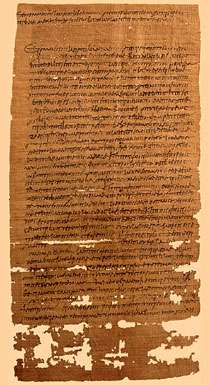Babatha
Babatha (also known as Babata) was a Jewish woman who lived in the town of Maḥoza (at the south-eastern tip of the Dead Sea in Jordan) at the beginning of the second century CE. In 1960, archaeologist Yigael Yadin discovered a leather pouch containing her personal documents in what came to be known as the Cave of Letters, near the Dead Sea. The documents found include such legal contracts concerning marriage (ketubba), property transfers, and guardianship. These documents, ranging from CE 96 to 134, depict a vivid picture of life for an upper-middle class Jewish woman during that time. They also provide an example of the Roman bureaucracy and legal system under which she lived.
Life

Babatha was born in approximately 104 CE in Maḥoza. Most likely the only child or the eldest daughter, she inherited her father's date palm orchard upon her parents’ deaths. By 124 CE, she had been married and widowed with a young son, Jesus. She was remarried by 125 CE to Judah, owner of three date palm orchards in Ein Gedi, who had another wife and teenage daughter.[1] It is uncertain whether Babatha lived in the same home as the first wife or if Judah traveled between two separate households, as polygamy was common and mandated by Law in the Jewish community.[2]
Analysis
The documents concerning this marriage offer insight to her status in the relationship. In their marriage contract, Judah's debts become part of her liability, indicating a financial equality. In 128 CE, a legal document shows that Judah took a loan without interest from Babatha, showing that she had control of her own money despite the union. Upon Judah's death in 130 CE, she seized his estates in Ein Gedi as a guarantee against his debts which she had covered as stated in the marriage contract.[3]
Another document of importance concerns the guardianship of Babatha's son. In 125 CE, Babatha brought a suit to court against the appointed guardians of her orphaned son, citing their insufficient disbursement of funds. The document contains Babatha's petition that full guardianship responsibility of her son and his property be transferred to her control.[4]
Death
The latest documents discovered in the pouch concern a summons to appear in an Ein Gedi court as Judah's first wife, Miriam, had brought a dispute against Babatha regarding their late husband's property. Therefore, it is assumed that Babatha was near Ein Gedi in 132 CE, placing her in the midst of Bar Kokhba's revolt. It is likely that Babatha fled with Miriam and her family from the imminent violence of the revolt. Because the documents were never retrieved and because twenty skeletal remains were found nearby, historians have suggested that Babatha perished while taking refuge in the cave.[5]
Further reading
- Friedman, Mordechai A. (1996). "Babatha's "Ketubba": Some Preliminary Observations". Israel Exploration Journal. 46 (1/2): 55–76. JSTOR 27926417.
- Broshi, Magen (1992). "Agriculture and Economy in Roman Palestine: Seven Notes on the Babatha Archive". Israel Exploration Journal. 42 (3/4): 230–240. JSTOR 27926273.
Notes
- Goodman
- Freund, 199-207.
- Freund, 200.
- Chiusi, 121.
- Freund, 201.
Bibliography
- Chiusi, Tiziana J. (2005). "Babatha vs. The Guardians of Her Son: A Struggle for Guardianship – Legal and Practical Aspects of P. Yadin 12-15, 27". In Ranon Katzoff and David Schaps (ed.). Law in the Documents of the Judean Desert. Leiden: Brill Academic.
- Goodman, Martin David (1996). "Babatha". In Simon Hornblower and Antony Spawforth (ed.). The Oxford Classical Dictionary (Third ed.).
- Freund, Richard A. (2004). "A Tale of Two Caves: Babatha and Her-story". Secrets of the Cave of Letters: Rediscovering a Dead Sea Mystery. Humanity Books. ISBN 978-1-59102-205-3. book cite
- Esler, Philip F. (2017). Babatha’s Orchard: The Yadin Papyri and an Ancient Jewish Family Tale Retold. Oxford: Oxford University Press.
External links
- Video Lecture on Babatha by Henry Abramson (2014)
- Lecture, Henry Abramson: Babatha (First Person Accounts in Jewish History) on YouTube, Jan 2020.
- Babatha's Life and Times
- Bibliography on Babatha
- Transcriptions of some of Babatha's papyri Duke Databank of Documentary Papyri